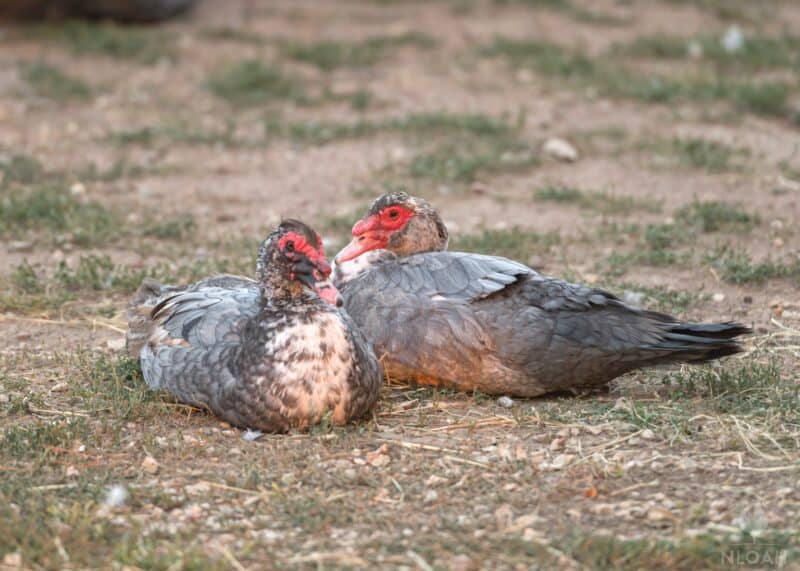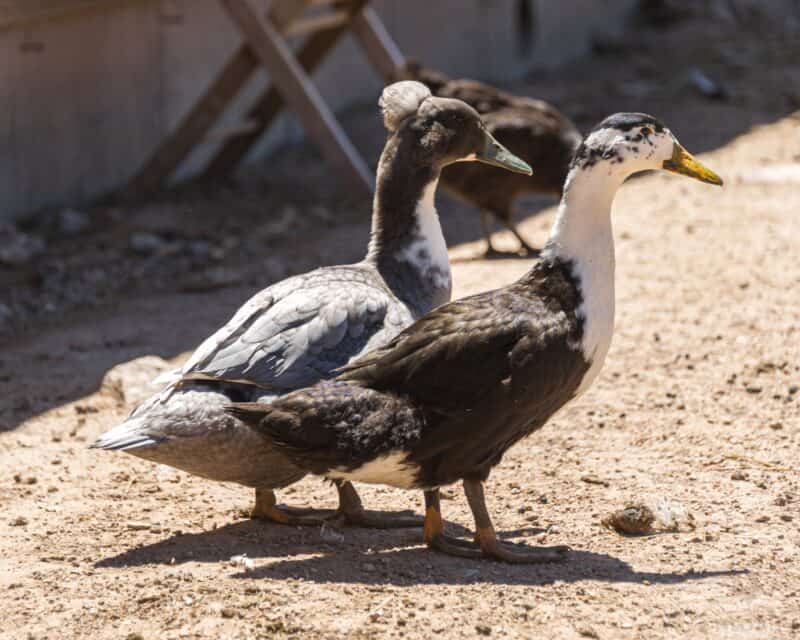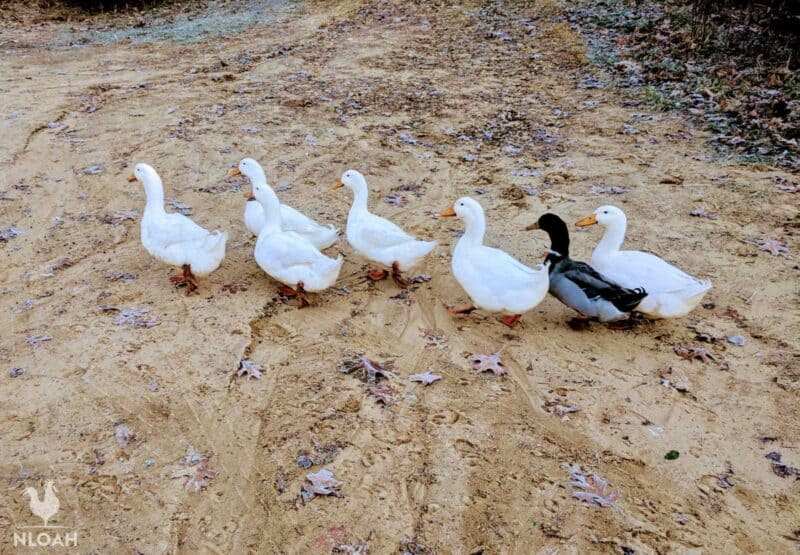With any livestock, picking the right breed is important for your happiness and also for your success, whatever it is that you might be doing. This is certainly true for ducks. If lots of meat is what you’re after, or you just enjoy having bigger birds around in your flock, you’ll be best served by a large breed.
It’s true that compared to chickens, most ducks tend to look pretty big, but only a few breeds are true giants! They’ll need more room of course, but in return, you’ll have a whole lot more duck to love. Check out our list of the top 10 largest duck breeds in the world below.
Golden Cascade
One of the most recent domestic ducks developed in North America, the subtle, light, pretty plumage of the Golden Cascade is set off strikingly by their dark legs and bills.
Weighing between 6 to 8 pounds, Golden Cascades enjoys a reputation for high vitality and activity, excellent health, fast growth, and reliable egg-laying. They are especially notable because they will typically lay all year round with little prompting.

Muscovy
Muscovies are truly unique in the domestic duck world. That’s because they are one of only very few that have not descended directly from Mallards.
These big, stocky but surprisingly athletic ducks can reach up to 15 pounds or even a little bit beyond in the case of males, making them consistently the biggest and heaviest on our list.
Muscovies are world-renowned for their intensely flavorful meat. So flavorful that some might even say it is an acquired taste! They’re also instantly recognizable by their bright red fleshy faces.
They might look pretty intimidating, but as long as you raise them right they can be as friendly and fun as any other breed. They’re also one of the quietest duck breeds on Earth, which is another perk in their favor!
Crested
Domestic Crested Ducks are instantly recognizable from the large spray or crest of feathers on the back of their heads. This is the result of a unique genetic mutation that they may or may not pass on to offspring.
This fancy haircut makes them greatly beloved by duck fanciers, but they are also decent egg layers, turning out about 130 annually.
Crested Ducks are one of the smaller varieties on our list, but still quite sizable, usually weighing between 7 and 8 pounds.

Swedish Blue
A rare but recovering breed here in the US, and significantly more common in Europe, there is a lot to recommend the Swedish Blue as the ideal domestic bird for backyard flocks or productive homesteaders alike.
On the smaller end of our tour of large ducks, the Swedish Blue weighs about 8 pounds at the absolute most, but is a remarkably productive specimen. Females will lay around 180 eggs every year, and this is another breed that is well-regarded for the quality of its fine-grained, lean meat.
Even better, they are superbly easy to handle being mild-mannered, calm, and friendly as long as they’re raised with plenty of socialization.
Swedish Blues often form a tight bond with the people who take care of them, so if you’ve ever wanted a duck that will act like your best buddy they are one of the best.
Aylesbury
An English breed that is truly a duck for connoisseurs, Aylesburys are known for their noisy but friendly demeanor and very high intelligence. Many owners claim they’re so smart that they can be taught commands and, sometimes, tricks!
This is a breed you won’t see very much in America and that’s unfortunate because they are a great meat breed, wonderful pets, and halfway decent layers, producing about 135 eggs yearly.
Although not the largest on our list, Aylesburys are consistently hefty and they have a plump, low build that makes them look bigger than they are. Females max out at around 7 pounds while males top out at about 8 or just a little more.
One downside with these ducks is that they tend to be surprisingly messy, even by usual duck standards. Make sure you’re ready for extra cleanup!
Saxony
Gorgeous, curious, active, and very friendly, Saxonies are a German duck instantly recognizable by their piebald or broken white and pale brown coloration. This is set off wonderfully by their bright orange legs and also their somewhat darker or muddier orange bills.
Topping out at 9 pounds, Saxonies are a true dual-purpose breed in every sense of the word. They’re high production layers that can give you anywhere from 190 to 245 eggs annually.
They are yet another breed famous for meat, and the skin of Saxony Ducks is said to be especially delicious. If you want to produce plenty of gourmet cuts with your flock, and get lots of eggs in the bargain, put the Saxony near the top of your list.

Cayuga
Far and away one of the most gorgeous ducks in the entire world, the shimmering, iridescent blue, green, and black coloration of the Cayuga makes them instantly recognizable. These large birds will weigh anywhere from 7 to 9 pounds.
For most owners, the sheer beauty of these birds is reason enough to own them, but they’re a capable dual-use breed in their own right: Cayugas can yield anywhere from 120 to 180 eggs yearly, and have dependably good meat.
Cayugas are big beauties to be sure.
Silver Appleyard
Big, beautiful, adventurous, and remarkably good mothers, Silver Appleyards are the total package when it comes to domestic ducks. Drakes weigh around 9 pounds, plus or minus, with hens being significantly lighter at about 7 pounds maximum.
Silver Appleyards grow quickly and are suitable for slaughter in just about two and a half months, and they are also prolific egg layers. Girls in their prime will lay anywhere from 200 to 275 large, pure white eggs every year.
They are a superb dual-purpose duck if you want a large breed, and one of the best free rangers around. If you have a large property with bountiful plant and insect life they can take care of themselves much of the time.
And, if you want to expand your flock naturally, they are excellent sitters and very caring, attentive mothers. This can work against you because they tend to go broody if you don’t remain very diligent about egg collection.
Even so, they’re famously sweet-natured and friendly with people, so they’ll never give you grief!
Rouen
A distinguished French heritage breed that is often mistaken for an extra-large Mallard, Rouens come in two varieties: production and exhibition, with the first being intended for meat and the latter being kept as a pet or show bird. The exhibition strain also grows much slower…
In any case, these are large ducks with males maxing out in the 12-pound range. Females tend to be considerably smaller, usually around 8 1/2 pounds. Famous for their rich, tender, and highly desirable meat, they’re capable of relatively low-volume egg layers: you’ll get 180 eggs from a female, at most.
They are more common in Europe than the US, but people are starting to appreciate them more and more here in America. They might be the right large breed for you!

Pekin
The most ubiquitous and in many ways the most loved domestic duck in North America, Pekins are big, bold, and beautiful.
They have pure, shining white feathers and bright orange bills, shanks, and legs, and this makes them the very image of what a duck is supposed to look like for most people.
Pekins are another giant duck with drakes reaching 12 pounds or a little bit more though females tend to be significantly lighter, topping out at about 9 pounds.
Typically bred for meat because they grow so quickly and reach an impressive weight, they are also surprisingly capable egg layers. Healthy hens can crank out up to 225 eggs per year.
Pekins are available everywhere, cheap, easy to handle, and very friendly making them a great duck for every keeper!

I’ve taken over this blog from Kendra Lynne around 2018, and turned it into one of the best an most comprehensive homesteading website out there. I was raised partly in the countryside living a very frugal life ever since I can remember.
